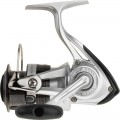Gear ratio
The gear ratio describes the difference in the speed of rotation of the spool and the handle. In reel specifications, it is often written as a ratio of the form x:1, where one indicates 1 turn of the handle, and “x” is the number of turns of the spool in one such turn. To simplify the record, only the first number is indicated in our catalog — for example, the designation 5.2 corresponds to a gear ratio of 5.2: 1.
First of all, the ratio between the speed and the "torque" of the coil depends on this parameter. So, high gear ratios allow you to quickly pull the line, which is important for high-speed wiring — but the power of such reels will be low, and significant efforts on the handle will be required to pull large prey. Conversely, at low numbers, the speed of the line will be small, but you will not have to make significant efforts to move it. In models of the inertialess type (see above), gear ratios of the order of 6 – 7 denote the so-called "high-speed" coils, 4 – 4.5 – "power", and intermediate values \u200b\u200bare universal. Due to their specificity, multiplier models usually have low gear ratios, and the high power of fly fishing reels is due to the fact that the angler rotates the drum directly in them, and the gear ratio is 1.
Spool size
The size of the main spool (drum) of the reel. This parameter directly affects the weight of the coil and its resistance to stress. It uses a symbol in thousands; in order not to go into unnecessary details, we can say that the larger the number in such a designation, the larger and heavier the drum. For different purposes, different sizes will be optimal. So, spools for 2500 – 3000 are considered universal, they can be used for both float fishing and spinning fishing in simple conditions. The smaller size is recommended for light tackle, including ultralight category, and equipment for large and heavy prey (for example, when fishing for carp) may include reels for 4500 – 5000 and
even more.
Spool capacity
The amount of line that can fit on the main spool of a reel with normal winding. It is indicated as a ratio of two numbers, the first of which corresponds to the length of the reeled line in metres, and the second to the thickness in millimetres: for example, the numbers 200 / 0.45 indicate that up to 200 m of fishing line with a thickness of 0.45 mm can fit on the reel.
For different types of fishing, there are recommendations on the optimal value of this parameter; they can be found in special sources. Here we note that the capacity of the spool is indicated exclusively for a smooth fishing line; when using a braided cord, the actual performance may differ markedly.
No anti-reverse switch
Reels without a mechanism that allows you to switch the winding of the line
in the opposite direction. In general, it is convenient to use the reverse stroke when you need to quickly and smoothly release the line without opening the line handle, or use the clutch to release the line under load.
Main spool material
The material from which the main spool (drum) of the reel is made. The term "main" is due to the fact that some models can be equipped with several interchangeable drums; see below for details. The materials used may be:
—
Plastic. The most simple and inexpensive option. In terms of strength, plastic can lose to more expensive materials, but for those coils where it is used, this is not decisive: such models are usually not designed for high loads, and a relatively short service life is compensated by a low price. In addition, this material weighs a little — and this means low inertia. At the same time, when buying a spinning reel with a plastic spool, it is worth considering its poor compatibility with braided cords: a rough cord runs along the plastic side with great friction, which negatively affects both the casting distance and the durability of the reel. But with fishing lines, such drums work without problems.
—
Graphite. In most properties, this material is similar to the plastic described above (including poor compatibility with braided cords); it is slightly more durable and durable, as well as, accordingly, higher cost.
—
Aluminium. Aluminium-based alloys used for spools have fairly high strength combined with low weight, moreover, in inertialess reels, they can work normally not only with fishing line, but also with braided cord
...s. With all this, such materials are somewhat more expensive than plastic and graphite, but not so much as to "raise the price to the skies." As a result, aluminium is found in a wide variety of coils, from relatively simple and inexpensive options to powerful premium models.
— Magnesium. The main advantage of magnesium alloys is considered to be very low weight, providing minimal inertia with high strength (surpassing even the aluminium alloys described above). At the same time, note that magnesium is very sensitive to certain corrosion factors, in particular to salt water — some manufacturers directly prescribe in the terms of the guarantee the inadmissibility of contact with it. Yes, and these spools are very expensive. Therefore, this option is used mainly in premium models.Weight
The total weight of the reel (only the device itself, without fishing line). This parameter is important, first of all, for those who select equipment of
the ultralight class — in such gear, the struggle is, as they say, for every extra gram. In other cases, you can not pay special attention to weight.

